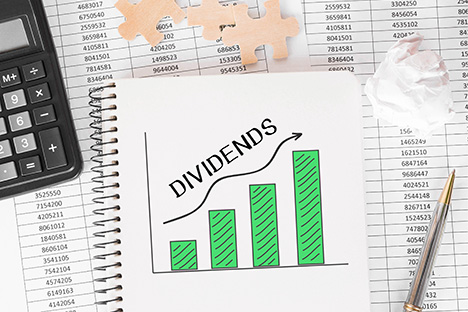Editor’s Note: Today’s guest column comes from The Oxford Club’s Senior Research Analyst Anthony Summers.
He recently wrote about our favorite topic (dividends!), so we couldn’t pass up the chance to share his insights.
Enjoy!
– Rebecca Barshop, Senior Managing Editor
Stock investing is one of the best, most proven approaches to building personal wealth. Over the long haul, few other asset classes can boast the performance that stocks have delivered.
It’s quite a marvel when you consider the speculative nature of it all.
Basically, stock investors risk capital today in the hopes of capturing a big reward sometime in the future. There’s no money-back guarantee (as you have with bonds) or other safety net (like the FDIC insurance you get on bank deposits) to prevent unexpected losses.
Buying a stock, even the safest stock you can imagine, is essentially a bet.
This is why many long-term investors turn to dividend-paying stocks. Not only do these stocks pay you to own them – generating income in the near term – but they’re also among the best stocks to own in general.
The Lifeblood of an Income Portfolio
Dividends are income paid to shareholders. In addition to interest-bearing bonds – or other income-generating assets such as real estate investment trusts – dividend-paying stocks are often the lifeblood of an income investor’s portfolio.
According to data from YCharts, approximately one-third of all stocks listed on major U.S. exchanges have paid a dividend over the past 12 months.

But not all dividends are created equal.
Many companies pay out sparingly. So a dividend paid last quarter doesn’t guarantee that another will be paid this quarter.
That makes frequency of payments a key factor in differentiating between low- and high-quality dividend-paying stocks. The best ones typically pay their shareholders on a regular schedule – whether annually, quarterly or even monthly.
However, the amount of the payout matters too.
Getting paid a penny per share might be better than getting paid zilch. But for investors who are mainly looking to get paid for owning the stock, a tiny dividend isn’t worth their time.
A simple gauge of this is a stock’s dividend yield, or its dividend per share (on an annual basis) divided by its price per share. For example, if a stock valued at $100 pays a dividend of $3 per share, its dividend yield is 3%. If the stock price falls to $50, the dividend yield rises to 6%.
Yes, decreasing share prices lead to increasing dividend yields.
This makes dividend stocks one of the few assets that see their perceived values rise as their share prices fall. That, in turn, makes them increasingly attractive to shareholders.
At face value, most dividend payers might seem to trade at low dividend yields. But yields fluctuate depending on both the stock’s price and the amount paid out per period.

But while yields fluctuate based on price, the payout for a high-quality dividend stock is consistent.
You shouldn’t have to guess when or what your next payout will be. So if you buy a stock with an annual dividend of, say, $5 per share, you should be able to feel confident that you’ll collect that $5 per share for years to come.
But in the very best-case scenario, that dividend should increase over time – even as consistently as it’s paid out year after year – causing the yield on your principal to rise.
In fact, you may be familiar with a group of stocks that are celebrated for their continual dividend increases…
Stock Market Nobility
Stocks with 25 or more consecutive years of dividend growth, commonly called “Dividend Aristocrats,” reign supreme in the stock market. And it’s not hard to see why.
A company willing and able to pay a growing dividend, for years or even decades on end, is highly prized and sought after in the market. And not just for the payouts…
A consistently rising dividend signals strong underlying financials too.
As you can see below, the Dividend Aristocrats have outperformed the S&P 500 over the past 20-plus years.

Compared with their non-dividend-paying peers, these are the real rainmakers in the stock game. And by reinvesting the dividends – using them to purchase more of the underlying shares – you can supercharge the stocks’ performance over the long term.
Even more importantly, you can use these high-quality dividend payers to help craft the perfect all-weather stock portfolio.
Not only have they proved able to deliver strong, long-term growth to a portfolio, but they can also provide stability thanks to their dividend payouts and their increased appeal during bear markets or recessionary periods.
